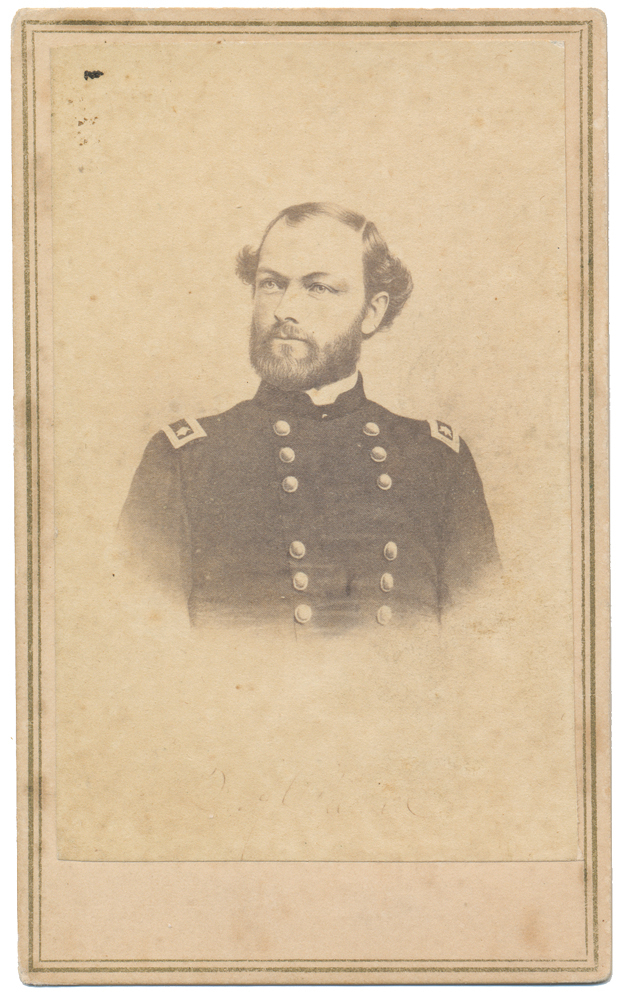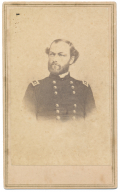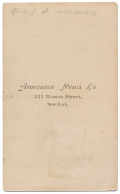site search
online catalog
CDV OF U.S. GENERAL QUINCEY A. GILLMORE

$100.00 SOLD
Quantity Available: None
Item Code: 1139-174
Chest-up view of Gillmore. He wears a double-breasted coat with shoulder straps. Image is clear with good contrast. The mount remains complete and in good condition. Photographer’s backmark, American News Co., New York.
Quincy Adams Gillmore (February 25, 1825 – April 11, 1888) was an American civil engineer, author, and a general in the Union Army during the American Civil War. He was noted for his actions in the Union victory at Fort Pulaski, where his modern rifled artillery readily pounded the fort's exterior stone walls, an action that essentially rendered stone fortifications obsolete. He earned an international reputation as an organizer of siege operations and helped revolutionize the use of naval gunnery.
He entered the United States Military Academy at West Point, New York, in 1845. He graduated in 1849, first in a class of 43 members. He was appointed to the engineers and was promoted to first lieutenant in 1856. From 1849 until 1852, he was engaged in constructing the fortifications at Hampton Roads in coastal Virginia. For the next four years, he was instructor of Practical Military Engineering at West Point and designed a new riding school.
With the outbreak of the Civil War in early 1861, Gillmore was assigned to the staff of Brig. Gen.Thomas W. Sherman and accompanied him to Port Royal, South Carolina. He took charge of the siege operations against Fort Pulaski. A staunch advocate of the relatively new naval rifled guns, he was the first officer to effectively use them to knock out an enemy stone fortification. More than 5,000 artillery shells fell on Pulaski from a range of 1,700 yards during the short siege, which resulted in the fort's surrender after its walls were breached.
Gillmore returned to New York City after the war. There he became a prominent civil engineer, authoring several books and articles on structural materials, including cement. Gillmore served on the city's Rapid Transit Commission that planned elevated trains and mass public transportation, and led efforts to improve the harbor and coastal defenses. He performed engineering work in other areas as well. He was involved in the reconstruction of fortifications along the Atlantic coast (including some that he had participated in destroying during the war).
General Gillmore died at Brooklyn, New York, at the age of 63.
This image was part of the Ray Richey collection. [jet] [ph:L]
~~~~~~~~~~~~~~~~~~~~~~~~~~~~~~~~~~~
THIS ITEM, AS WITH ALL OTHER ITEMS AVAILABLE ON OUR WEB SITE,
MAY BE PURCHASED THROUGH OUR LAYAWAY PROGRAM.
CLICK HERE FOR OUR POLICIES AND TERMS.
THANK YOU!
Inquire About CDV OF U.S. GENERAL QUINCEY A. GILLMORE
For inquiries, please email us at [email protected]
Most Popular
Historical Firearms Stolen From The National Civil War Museum In Harrisburg, Pa »
Theft From Gravesite Of Gen. John Reynolds »
Selection Of Unframed Prints By Don Troiani »
Fine Condition Brass Infantry Bugle Insignia »
British Imported, Confederate Used Bayonet »
Scarce New Model 1865 Sharps Still In Percussion Near Factory New »
featured item
IDENTIFIED CONFEDERATE CAPTAIN’S FROCK COAT OF CAPTAIN PHARES WALDO SHEARER, 45th MISSISSIPPI, WITH 28-PAGE REMINSCENCES AND VETERAN’S BADGE- HE EXCHANGED SALUTES WITH THE WOUNDED JOHN BELL HOOD AT CHICKAMAUGA
This coat came directly out of the family along with a reunion badge and type-written copy of the officer’s 1906 reminiscences. The coat was formerly in the collection of Steve Mullinax, is accompanied by a file containing details of its… (1179-179). Learn More »
site search
Upcoming Events
May 16 - 18: N-SSA Spring Nationals, Fort Shenandoah, Winchester, VA Learn More »




